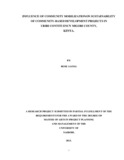| dc.description.abstract | The study sought to investigate influence of community mobilization on the
sustainability of community based development projects in Uriri constituency Migori county
Kenya. The background of the research is based on Operational Mobilization in Europe and
India that led to the spread of the Gospel of Jesus Christ. In Africa, Ghana and Angola have
been captured on how mobilization reduced slave trade. In Kenya Narok county and Homabay
County have been put on the spot on how to take control of their development. The study
therefore sought to achieve the following objectives. To investigate the influence of community
awareness creation on the sustainability of community based development projects, to establish
the influence of community participation on the sustainability of community based development
projects, to investigate the extent to which empowerment influences the sustainability of
community based development projects, to assess the contribution that identification of
resources would have on the sustainability of community based development projects and to
investigate the extent to which community leadership would have on sustainability of
community based development projects. The study captured significance of the study,
limitations of the study, delimitations of the study, basic assumptions of the study, and
definitions of significant terms. The study reviewed literature on the concept of community
awareness creation, community participation, community empowerment, community leadership
and identification of resources. The study employed as its research methodology, a descriptive
survey research design. The method of data collection was survey and the data collection
instrument that was used in the study was the questionnaire which was pre-tested through a pilot
study to establish its validity and reliability. The study targeted 3030 members of community
based development projects in the constituency and 10%of this population will form the study
sample size of 303 respondents. Probability sampling design involving stratified random
sampling procedure was used in which the projects were stratified on the basis of project types
such as youth group projects, women group projects, self-help group projects and community
based group (CBO) projects. Chapter four captured, data presentation, analysis, interpretation
and discussion. Data was analyzed using quantitative techniques such as measures of central
tendencies and measures of spread with the help of Statistical Package for Social Scientists
(SPSS). Data was presented using frequency distribution tables and percentages. The first part
of chapter four covered the demographic characteristics of the respondents while the second part
contained analysis of influence of community awareness creation, community participation,
community empowerment, community leadership and identification of resources on the
sustainability of community based development projects in Uriri constituency Migori county
Kenya. Chapter five contained introduction on the chapter, summary of the findings,
conclusion, contribution of the study to the body of knowledge, recommendation for policy
action and suggestions for further research | en_US |

